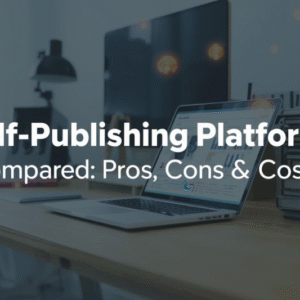If you’re searching for a way to create steady income streams without the hassle of shipping, storage, or managing physical inventory, digital products are a smart option. They give you the freedom to build something once and sell it over and over, which makes them a big win for creators, educators, and anyone who wants a more flexible, online-driven lifestyle.
Whether you hope to work from a laptop while traveling or just want to earn a little extra each month, digital products offer possibilities for people with all kinds of interests and skills. There’s a digital product for everyone, whether you love design, teaching, writing, or coding.
If you’re eager to jump in but aren’t sure what to sell, browse this list of 10 profitable digital products. You’ll find ideas you can get started with right away, even if you’re a newcomer to online business.
TL;DR: 10 Profitable Digital Products to Sell Today
- Digital products are sold online again and again, with zero shipping or storage required.
- Top choices include online courses, printables, digital templates, ebooks, stock photos, and several others.
- You can start small, keep your expenses low, and scale things up as you gain experience.
1. Online Courses and Workshops
Sharing what you know can be rewarding, in both impact and income. Online courses and workshops let you teach your skills to people all around the world. Platforms like Teachable, Udemy, and Skillshare make setting up lessons, recording videos, and offering downloadable extras super easy. You can focus on almost any subject: cooking, coding, marketing, baking, language learning, painting, fitness, organization, or even public speaking. If you can break something down step-by-step, you’re set.
How to Get Started:
- Pick a topic you know well and see that there’s demand for it (even your hobbies could work).
- Sketch out a basic course or workshop plan. Don’t stress about perfection.
- Record your content with a phone or computer (Zoom or Loom are great), then upload to your chosen platform and launch.
2. Printables and Planners
Printable planners, calendars, worksheets, stickers, and journals are consistently popular on platforms like Etsy or Shopify. Design a PDF or PNG just once, and customers can buy and download them instantly, no packaging or mailing necessary. Organized folks, scrapbookers, budgeters, and anyone who loves a good checklist snap these up.
What Sells Best:
- Habit trackers, budget templates, wedding planners, study guides, kids coloring sheets, and goal trackers are always in demand.
- Make your printables visually appealing and colorful; this helps them stand out and get attention.
You can even add extra value by grouping related printables into bundles or offering seasonal variations like holiday planners or themed checklists to attract different buyers throughout the year.
3. Website Templates and Themes
If you have web design experience, selling digital templates for WordPress, Shopify, or Squarespace can be a solid income source. Not everybody wants to build a website from scratch. Simple, customisable templates are always in demand, especially from solo entrepreneurs and small business owners with limited time.
Ideas for Templates:
- Landing page templates, full site designs, ecommerce store themes, or stylish portfolio layouts.
- Group related templates together for attractive bundle deals that boost your average sale.
Check out marketplaces like ThemeForest or Creative Market to get a sense of what designs are currently popular, and what price points people are willing to pay.
4. Ebooks and Guides
Ebooks and practical guides are still a strong product, especially for niche audiences. No need to create a 500-page saga, a focused ebook of 20 to 50 pages packed with tips or how-tos is plenty. Think actionable advice, checklists, recipe books, or concise cheat sheets. Amazon Kindle Direct Publishing and Gumroad are easy ways to publish.
Quick Tips:
- Stick to hands-on advice or clear solutions (“How to Start Transcription as a Side Hustle” or “Easy Beginner’s Guide to Meal Prep”).
- Make the ebook visually inviting, consider adding illustrations, templates, or checklists as bonuses to increase value for buyers.
You could also offer an audiobook version or an ebook bundle to reach even more customers.
5. Stock Photos and Graphics
If you enjoy photography, illustration, or graphic design, uploading your work to stock image platforms can provide a passive stream of income. Businesses, bloggers, and marketers browse these sites regularly for eye-catching visuals to drop into web pages, social posts, eBooks, and ad campaigns.
Where to Sell:
- Shutterstock, Adobe Stock, Depositphotos, and Creative Market are a good place for beginners.
- Niche platforms (like those focusing on food, travel, or pet photography) can give you better payouts for truly unique content.
You can also create and sell brand kits, logo packs, or icon sets for people wanting to build a consistent visual presence without hiring a pro designer.
6. Audio Products: Music, Samples, and Podcasts
Musicians, producers, and hobbyists have lots of opportunities online. You can sell royaltyfree music tracks, sound effects, loops, or even pre-recorded podcast episodes. DJs, video editors, businesses, and content creators are always on the lookout for fresh audio.
Popular Audio Product Ideas:
- Podcast intro themes, meditation background soundscapes, ringtone packs, or instrumental tracks for YouTube videos and social ads.
- Platforms like AudioJungle, Pond5, and Patreon are great for getting your audio to buyers quickly.
If you’re serious about turning this into a full-fledged venture, consider offering music packs or bundles tailored for specific genres or moods to snag more downloads.
7. Digital Art Prints and Wall Decor
Artists and designers can turn their digital artworks into wall prints, posters, or quote graphics for instant download. Unique art helps people personalize their homes and offices, and all you need to supply is a high-resolution file. Selling on Etsy or through a personal Shopify site works really well in this space.
Trending Ideas:
- Inspirational quote prints, botanical art, boho decor, and bold abstract designs are especially trendy.
- Create matching series or sets for living rooms, nurseries, or offices, many shoppers look for cohesive looks.
To add a twist, you might offer custom color options for customers seeking a personalized touch.
8. Software, Apps, and Plugins
If you’re techsavvy, building small software tools, mobile apps, or website plugins can bring in significant rewards. Simple apps that address a pain point, like budgeting tools, productivity trackers, social media schedulers, or site security add-ons are in high demand for digital business owners and hobbyists alike. Launching on the Apple App Store, Google Play, or your own website can connect you to tons of eager users.
Starter Ideas:
- Simple productivity apps, chatbots for websites, SEO and analytics plugins, or even task manager tools.
- Focus on solving a specific problem, then collect user feedback and continue improving your product. Start small, then add more features as you grow.
If you build plugins or extensions for WordPress or Shopify, make sure to keep them updated and provide clear documentation for users.
9. Social Media Content Packs
Businesses and influencers are always searching for new graphics and clever captions. Social media content packs, including Instagram templates, story highlight covers, Facebook ad graphics, or Pinterest pins, are reliable sellers. Canva and Photoshop make designing these a breeze, even if you’re not a pro designer.
What Works for Buyers:
- Modern, colorful, and trendy templates ready for customization.
- Bundle sets that include posts, matching stories, captions, and calltoaction ideas can help buyers complete their whole content calendar at once.
You can stand out by offering themed packs for seasons, holidays, or niches like wellness, finance, or real estate.
10. Memberships and Paid Communities
If building relationships and sharing support excites you, a paid community or membership site might be your best bet for recurring online income. People join these for exclusive content, Q&A sessions, downloadable templates, expert videos, or personalized guidance. You can run memberships through platforms like Patreon, Circle, or even a private Discord group.
Membership Perks:
- Monthly workshops, downloadables, feedback groups, and one-on-one advice sessions.
- This approach works for writers, fitness coaches, craftspeople, small business owners, and just about anyone with expertise to share.
To grow your membership quickly, offer free trials or special discounts for early adopters to build buzz and trust within your niche.
Summary: Why Digital Products Are Worth Trying
Digital products are extremely flexible, with almost no overhead and unlimited potential for scaling up. They can match almost any interest or skill. With minimal startup costs, you can experiment and refine your ideas before making a serious financial commitment. The most challenging step is simply picking what product suits you and going for it. Once you get your first sale, momentum usually picks up, it’s often a confidence boost and makes further growth easier to imagine.
Digital products let you explore creative outlets, share expertise, and help your audience while pocketing income from anywhere. There’s never been a better time to get started!
Common Questions About Selling Digital Products
Do I need special tech skills to sell digital products? Not necessarily. Most platforms have made it easy for all skill levels, and tools like Canva help beginners with design and formatting. If you want to sell software or apps, some coding experience is handy, but you can also bring in freelancers to build more advanced features.
How should I price my digital products? It’s smart to see what others charge in your niche. Start in the same ballpark, then experiment with different price points to gauge buyer interest. As you rack up positive reviews and experience, raising prices is expected and often worthwhile.
Can I sell digital products on multiple platforms at once? Absolutely! Many creators list products across marketplaces for more exposure. Just make sure to check each site’s policies about exclusivity before posting the same product in multiple places.
What if someone copies or shares my product? Protecting digital content is always a challenge. Add discreet watermarks, use platforms that limit unauthorized sharing or track downloads, and always include clear terms of use. Most buyers will respect your work if you set expectations upfront.
Final Thoughts
There are so many ways to earn online by selling digital products, no boxes, shipping labels, or supply chains to mess with. The 10 ideas above should get your creative wheels spinning so you can test, learn, and grow on your own schedule. Start with something tied to your skills or favorite hobbies, take advantage of ready-made tools, and don’t be afraid to adjust as you go. With some creativity, patience, and a willingness to keep learning, digital products can quickly become a steady income source, no matter if your goal is a weekend side hustle or a full-fledged career switch.
Let’s make it happen!





